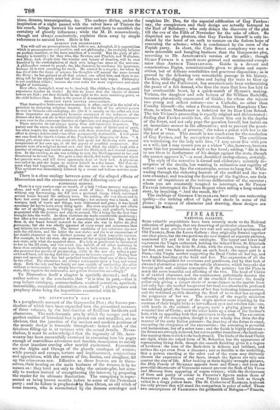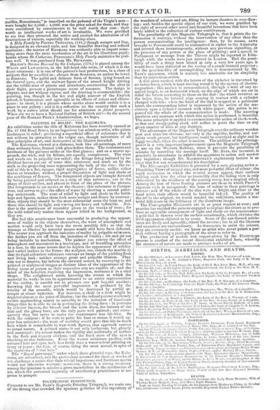FINE ARTS.
NATIONAL GALLERY.
SOME valuable acquisitions have been recently made to the National collection of paintings, that are deserving of particular attention. The finest and most precious are the two rare and unequalled specimens of Old FRANCIA, from the Lucca Gallery : they originally formed together one altar-piece, but the two portions are now framed as separate pictures, numbered 179 and 180 in the catalogue. The larger and lower half represents the Virgin enthroned, holding the infant Christ, St. Elizabeth seated beside her, the little St. John, with the cross, running below at her feet, and two Saints standing on each hand : the upper part is a Pieta,—the, Virgin mother supporting the Dead Christ on her lap, and two Angels kneeling at the head and feet. The expression of all the heads is distinguished for sweetness and gentleness, and by that look of elevated abstraction proper to the saintly character, which bespeaks the devout spirit and sublime conception of the painter ; but the Pieta is much the more beautiful and affecting of the two. The head of Christ is of exalted character, and the countenance pathetically denotes the suffering and divine resignation of the crucified Saviour ; the deadly pallor only giving a deeper shade of mournfulness to the marble brow and ashy lips : the mother hangs over her dead son absorbed in profound but subdued grief; the lineaments of her face indicating intense sorrow, and the reddened eyelids showing the flood of tears that has assuaged the poignancy of her wo. The serenity of the angelic ministers makes the human agony of the virgin mother more touching by the contrast of their bright looks to her suffused eyes and swollen lids : one, with hands in the attitude of prayer, casts a pitying glance at the wounded feet of Christ ; and the other holds up a tress of the Saviour's hair, with an appealing look that penetrates to the soul. The execution is worthy of the conception, though it is not wholly free from the dry manner of the early Italian painters : the drawing of the forms is exact, excepting the elongation of the extremities ; the colouring is powerful and harmonious, but of a sober tone ; and the finish is highly elaborate : the forms are strongly relieved, but not to perfect roundness ; the hard out- line causing them to stick to the background. The limbs of the dead Christ are rigid, while the naked form of St. Sebastian has the appearance of representing living flesh', though the smooth finishing gives it a degree of hardness : the tone of the flesh-tints is delicate and brilliant, and strikes the eye even from a distance ; and so forcible is the modelling, that a person standing at the other end of the room may distinctly discern the expression of the faces, though the figures are only one quarter the size of life. After looking at these highly-wrought pictures, the Holy Family of MURILLO appears loose and flimsy ; and even the powerful chiaroscuro of CORREGIO cannot prevent the flesh of his Venus and Mercury from appearing of coarse texture; while the distinctness of form and purity of colour in FRANCIA'S figures makes those of SEBASTIAN DEL PIOMBO, and even TrraAN himself, look as though veiled in a dingy yellow haze. The St Catherine of RAPHAEL is almost the only picture that will stand the comparison in point of relief. These two masterpieces of FatexcEsco the goldsmith of Bologna—" Francis,
aurifex, Bononiensis," is inscribed on the pedestal of the Virgin's seat— were bought for 3,5001. ; 4,0001. was the price asked for them, and they were considered by connoisseurs to be well worth that sum : their worth as intellectual works of art is invaluable. We were gratified to see that they attracted the notice and excited the admiration of all descriptions of visiters, especially the working-class.
A Holy Family by PIETRO PERUGINO, (181,) though meagre and Hay. is designed in an elevated style, and has beautiful drawing and refined sentiment : the master of RAPHAEL was evidently able to impart some- thing more than the mere mechanism of the art to his illustrious pupil ; beside whose St. Catherine, PERUGINO'S Holy Family maintains its posi- tion well. It was purchased from Mr. BECKFORD.
HILTON'S Serena Rescued by Sir Calepine, (178,) is placed among the WESTS and LAWRENCES, in the left-hand side room, of which it is the finest ornament : it is one of the painter's best productions, in a class of subjects that he excelled in ; chosen from SPENSER, an author he loved to illustrate. The pallid and delicate form of Serena, lying bound on the funeral pyre, and the stalwart figure of the armed knight driving out the rabble-rout of priests and attendants, overturning the altar in their flight, present a picturesque scene of romance. The design is elegant, and not without vigour, and the drawing is commendable ; the painting, too, though in the lax and slight manner of the English school, is harmonious and agreeable in its effects of colour and chiaro- scuro: in short, it is a picture whose merits alone would entitle it to a place in any gallery ; and it is a reflection on the country that such a work by a native artist should sue for admission in forma pauperis. When are we to have a National Gallery of British art P—In the second year of Sir ROBERT PEEL'S Administration, we hope.



























 Previous page
Previous page